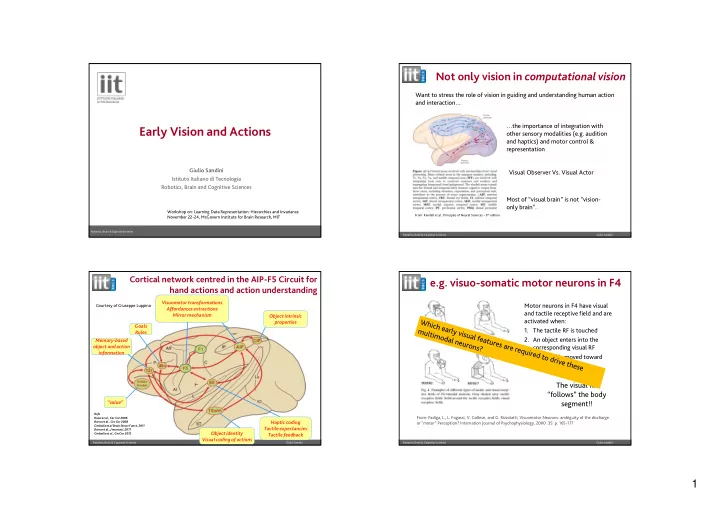

Not only vision in computational vision Want to stress the role of vision in guiding and understanding human action and interaction… …the importance of integration with Early Vision and Actions other sensory modalities (e.g. audition and haptics) and motor control & representation Giulio Sandini Visual Observer Vs. Visual Actor Istituto Italiano di Tecnologia Robotics, Brain and Cognitive Sciences Most of “visual brain” is not “vision- only brain”. Workshop on: Learning Data Representation: Hierarchies and Invariance From: Kandell et.al.: Principles of Neural Sciences – 5 th edition November 22-24, McGovern Institute for Brain Research, MIT Robotics, Brain & Cognitve Sciences Robotics, Brain & Cognitive Sciences Giulio Sandini Cortical network centred in the AIP-F5 Circuit for e.g. visuo-somatic motor neurons in F4 hand actions and action understanding Visuomotor transformations Motor neurons in F4 have visual Courtesy of Giuseppe Luppino Affordances extractions and tactile receptive field and are Mirror mechanism Object intrinsic activated when: properties Goals 1. The tactile RF is touched Rules 2. An object enters into the Memory-based object and action corresponding visual RF information 3. The hand is moved toward that region The visual RF “follows” the body “value” segment!! Refs From: Fadiga, L., L. Fogassi, V. Gallese, and G. Rizzolatti, Visuomotor Neurons: ambiguity of the discharge Rozzi et al., Cer Cor 2006 Borra et al., Cer Cor 2008 Haptic coding or "motor“ Perception? Internation Journal of Psychophysiology, 2000. 35: p. 165-177. Gerbellaet al Brain Struct Funct, 2011 Tactile expectancies Borra et al., J neurosci, 2011 Object identity Gerbellaet al., CerCor 2012 Tactile feedback 3 Visual coding of actions Robotics, Brain & Cognitive Sciences Giulio Sandini Robotics, Brain & Cognitive Sciences Giulio Sandini 1
… canonical neurons in F5 representing Object properties can also be coded in visual properties of objects in motor terms terms of motor primitives Active when manipulable objects are presented o Position of objects can be coded in terms of the action visually (grasp specific) required to reach it o Trajectory of objects can be coded in terms of “collision trajectory” (which body part is going to hit) o Shape/Size can be coded in terms of “grasp type” (small is whatever can be grasped with a pinch grasp) It is not the shape of the object that matters but Observation + action how you can grasp it Observation only …small like this… From: Fadiga, L., L. Fogassi, V. Gallese, and G. Rizzolatti, Visuomotor Neurons: ambiguity of the discharge or "motor“ Perception? Internation Journal of Psychophysiology, 2000. 35: p. 165-177. Robotics, Brain & Cognitive Sciences Giulio Sandini Robotics, Brain & Cognitive Sciences Giulio Sandini Recognize an object without the Size information and reaching object (shape from action) human ability to extract some intrinsic object features, such as shape and size, from a visually presented reach-to-grasp movement. • How relevant is “action” Third Person in recognizing objects? First Person • Can the visual system exploit the view of haptic exploration to extract shape information of the explored object? Size is coded in the action to reach (and point of view matters) Campanella Sandini, Morrone, Proc. R. Soc. B, 2010 Study done with Francesco Campanella Robotics, Brain & Cognitive Sciences Giulio Sandini Robotics, Brain & Cognitive Sciences Giulio Sandini 2
How can we exploit the regularities of Modelling the Recognition of Biological human motion to “tune” early visual Motion feature extraction? Hierarchical models exploring the relationship between the ventral and the dorsal streams Bell shaped velocity profile in reaching movements produce perspective invariant features on the retina of the actor and of the observer. Jhuang , Serre, Wolf and Poggio- ICCV 2007 From: P. Morasso – Exp. Brain Res. - 1981 From: Atkeson & Hollerbach – J. Neuroscience 1985 Giese & Poggio 2003 Also: (Morasso 1981 , Morasso Mussa-Ivaldi 1982, Abend, Bizzi, Morasso, 1982) Robotics, Brain & Cognitive Sciences Giulio Sandini Robotics, Brain & Cognitive Sciences Giulio Sandini “Human Motion Features” that could Laquaniti’s “2/3” Power Law be exploited to tune early visual processes Isogony Principle: In drawing movements, equal angles are • Regularity of velocity profile described in equal times (angular • Position and time of changes of curvature (for segmentation) velocity tends to remain constant when the radius of curvature • Relation between trajectory’s curvature and velocity (e.g. 2/3 changes). power low) Viviani & Terzuolo 1982. • Local rigidity (invariance of distance between joints) From: Laquaniti, Terzuolo, Viviani – Acta Psychologica - 1983 • Common motion (not equal velocity but equal “visuo-motor pattern” – e.g. clouds of points with similar velocity profile or In rhythmic drawing movements, Laquaniti et. al. noted a power law relationship oscillations). with proportionality constant k between the angular velocity a ( t ) of the hand and • Influence of gravity on trajectory. the curvature of the trajectory path c ( t ): • … a ( t ) = k c ( t ) 2/ 3 Robotics, Brain & Cognitive Sciences Giulio Sandini Robotics, Brain & Cognitive Sciences Giulio Sandini 3
Questions for a possible discussion • How can “motor knowledge” and the regularities of motor control be exploited to design/tune/learn how to compute Thanks! early visual features? • Is “looking at one’s own body” a useful method to learn such features? • How far can we go with only “bottom-up”, feed forward models to explain human movement perception? • What is innate and what is learned (and how)? Robotics, Brain & Cognitive Sciences Giulio Sandini Robotics, Brain & Cognitive Sciences Giulio Sandini 4
Recommend
More recommend